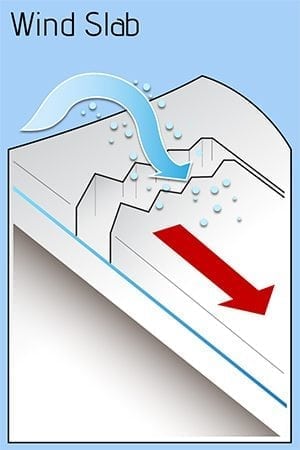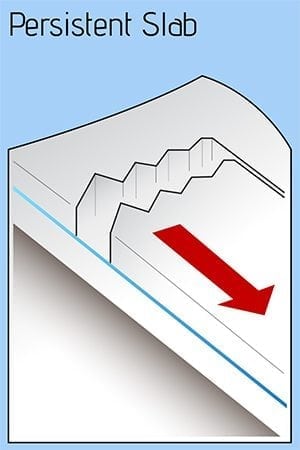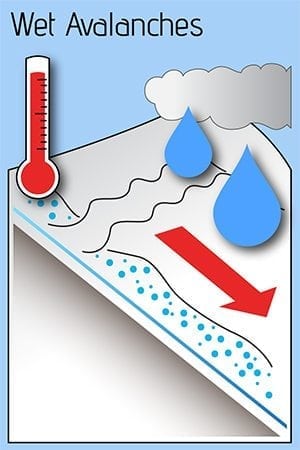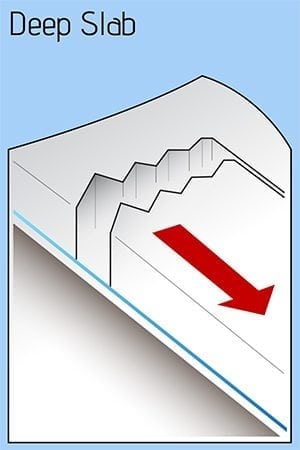Valdez
Above 4,000ftModerate
2,000 to 4,000ftModerate
Below 2,000ftModerate
Degrees of Avalanche Danger
Avalanche Problems
Problem 1
Recent northeast winds have created wind slabs 2-8 inches deep that were reported and observed as reactive on lee aspects (SE-NW) on 4/1. Wind slab sensitivity will be decreasing as time goes on. On 4/2, human triggered avalanches remain possible in specific locations, especially on the lee side of high elevation ridge lines and cross loaded terrain. Pay attention to wind distribution patterns, the depth of slabs and their sensitivity in the area you choose to travel. Small wind loaded test slopes are a great way to test the sensitivity of wind slabs at the surface.
Likelihood:
- Almost Certain
- Very Likely
- Likely
- Possible
- Unlikely
Size:
- Historic
- Very Large
- Large
- Small
Trend
- Increasing
- Steady
- Decreasing
Problem 2
Surface hoar that was buried on 3/30 has been reported as existing in isolated locations. In one location on 3/31 this layer was reported as being reactive in upper elevations of the Maritime climate zone, while other areas showed better stability. The 3/30 buried surface hoar layer is expected to be spotty or isolated in its distribution. This can create the potentially dangerous set up where a group can be lured into complacency as good stability is encountered in some areas, while slopes in close proximity could harbor a persistent weak layer. Incremental snowfall looks likely mid next week which will be adding stress to this layer. This layer has the possibility of existing at mid-upper elevations on northerly aspects.
Other faceted weak layers exist in our mid snowpack, although these have become dormant over the last 10 days as no major loading events have occurred since the 3/25 wind event. The most likely area to trigger a persistent slab avalanche will be in the Continental zone, where a more faceted snowpack exists.
Persistent weak layers have the potential to reactivate later in the season if we return to a period of heavy precipitation and/or the suns energy begins to penetrate deeper into the snowpack.
Likelihood:
- Almost Certain
- Very Likely
- Likely
- Possible
- Unlikely
Size:
- Historic
- Very Large
- Large
- Small
Trend
- Increasing
- Steady
- Decreasing
Problem 3
Wet loose activity will be limited today due to clouds and wind keeping the solar aspects cooler. Clouds during the first half of the day will limit the amount of time the suns energy can melt snow at the surface. Once the sun comes out this afternoon, the possibility to see wet loose activity will be increasing. Todays activity is expected to be low volume and less widespread.
The size of the terrain being exposed will directly correlate to the size of natural activity that is possible. Small slopes will likely only produce roller balls and low volume wet loose activity. While large steep solar aspects have the potential of entraining significant amounts of snow and producing very dangerous, large wet loose avalanches. Steep areas near rocks will be the first to warm up during the day. Step downs to slab activity will become increasingly possible as the Spring moves on and the sun becomes more intense.
Assesment and avoidance of this avalanche problem is relatively easy. Pay attention to the amount of warmth that is being transferred into the snow surface (Is it becoming moist-wet?). Avoid traveling on or being exposed to steep south aspects where the surface snow is becoming moist-wet during the heat of the day.
Likelihood:
- Almost Certain
- Very Likely
- Likely
- Possible
- Unlikely
Size:
- Historic
- Very Large
- Large
- Small
Trend
- Increasing
- Steady
- Decreasing
Problem 4
Weak snow exists at the base of our snowpack. This weak snow is currently unlikely to be affected due to the strength of old wind affected snow at the 3/17 new/old interface. Depth hoar may become a concern later in the season if our area returns to a period of major snowfall and the very strong wind damaged layer at the new/old interface starts to break down and lose strength within the snowpack. As very hard wind slabs break down within the snowpack a person or machines weight will have a more direct affect on weak layers at the bottom of the snowpack. In addition, the increasing intensity of the sun will be putting pressure on deep layers during the heat of the day.
Likelihood:
- Almost Certain
- Very Likely
- Likely
- Possible
- Unlikely
Size:
- Historic
- Very Large
- Large
- Small
Trend
- Increasing
- Steady
- Decreasing
Avalanche Activity
Below is a summary of observed Avalanche activity from the last 7 days. Avalanches that were noted earlier in the season can be viewed by clicking the link below.
If you trigger or observe an avalanche consider leaving a public observation.
4/1- Multiple skier triggered D1 avalanches were reported on a variety of aspects. These were wind slabs in the 4-8 inch range.
3/31- Skier triggered avalanche reported at high elevation of the Maritime climate zone. This failed on surface hoar that was buried on 3/30. No skier involvement. Crown depth was 4-8 inches.
3/24- Ski cuts were reported as being productive, with avalanches up to D2 at the 3/21 interface.
3/18-21- Several D1-D2 human triggered avalanches have been reported. For the most part these have been outside our forecast zone and appear to be more likely in areas with either a weaker underlying snowpack (continental zone) or where storm totals were higher (SE of Thompson Pass). Remote triggers have also been reported as the Hamilton storm slab has settled and gained cohesion.
3/17- Multiple D1-D2 natural storm slab avalanches were reported and observed along the road corridor. These all failed within the storm snow with the exception of one deep persistent avalanche reported on Billy Mitchell.
Weather
Check out our updated weather tab! A collection of local weather stations are available for viewing with graphs and tabular data included.
NWS Watches, warnings and advisories
NONE
NWS Point forecast for Thompson Pass
Date Sunday 04/02/23 Monday 04/03/23 Time (LT) 04 10 16 22 04 10 16 22 04 Cloud Cover OV OV SC FW FW SC BK OV OV Cloud Cover (%) 80 80 35 5 10 35 70 95 90 Temperature 16 19 26 18 13 18 28 21 18 Max/Min Temp 26 12 28 17 Wind Dir NE NE NE NE NE NE SE S S Wind (mph) 6 4 14 16 17 10 5 6 4 Wind Gust (mph) 34 Precip Prob (%) 5 5 10 5 0 0 0 5 10 Precip Type 12 Hour QPF 0.00 0.00 0.00 0.00 12 Hour Snow 0.0 0.0 0.0 0.0 Snow Level (kft) 0.0 0.0 0.0 0.0 0.0 0.0 0.0 0.0 0.0
Click on link below for Thompson Pass weather history graph:

| Date:
04/02 |
24 hr snow | HN24W* | High temp | Low temp | 72 hour SWE* | April snowfall | Seasonal snowfall | Snowpack Depth |
| Valdez | 0 | 0 | 41 | 27 | 0 | 0 | 236 | 51 |
| Thompson Pass | 0 | 0 | N/O | N/O | 0 | 0 | 428 | N/O |
| 46 mile | 0 | 0 | 38 | 10 | 0 | 0 | ~115** | 54 |
*HN24W- 24 hour Snow water equivalent in inches
*SWE– Snow water equivalent
**46 mile seasonal snowfall total begins December 1st.
Additional Information
Click on the link below for a running summary of the seasons weather history.
Announcements
The avalanche hazard is moderate at all elevations. There remains the possibility to trigger a wind slab avalanche less than one foot in depth in specific locations. The sensitivity of this problem is expected to decrease today. Wet loose activity will be limited by cloud cover and north wind on 4/2. Check the depth and sensitivity of wind slabs at the surface in areas you choose to travel.
Posted by Gareth Brown 04/02 8:00 am.
For a description of current avalanche problems, weather information, season history and more click the (+ full forecast) button. Avalanche forecasts will be issued Wednesday-Sunday.
If you have pictures of recent natural or human triggered avalanches or notice signs of instability such as shooting cracks or collapsing, leave an observation to help improve forecast accuracy.



